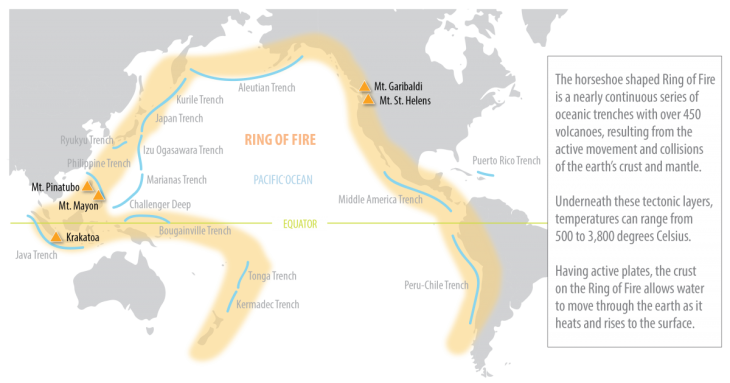In the simplest terms, geothermal means ‘heat from the earth’. Volcanic activity in the Pacific basin means deep underground water aquifers are heated by magma rising from the earth’s core.
British Columbia is situated on the Pacific Ocean “Ring of Fire” and this area has been identified as having substantial geothermal energy potential.

Wells are drilled into the hot reservoirs and the water (and in some cases steam) is moved to the surface by pumping. Once the water is at surface, the heat is extracted and used to produce electricity or for other commercial purposes such as heating buildings, warming greenhouses or used for recreation, such as hot springs. The temperature of the water determines the use – very hot water (or steam) can be run through turbines and used for electrical generation. Cooler water (or the water after electricity has been generated) can be used for area heating.
British Columbia has the potential for geothermal resource throughout the province, and several studies have been undertaken by Geoscience BC.
Ground source heat pumps are often referred to as a source of geothermal energy. Although technically correct, this low-grade geothermal energy is normally used for small-scale heating or cooling. Pipes are run in soil or in shallow wells and a non-freezing fluid is circulated through these pipes. A heat pump then extracts the heat and circulates it throughout into a house. These reservoirs are typically 5-12°C, compared to reservoirs used for generating power, which are in excess of 80°C.
How does geothermal energy work?
Generally, for a geothermal resource to be viable, three characteristics must be present: high temperatures, water and permeability in the reservoir. In British Columbia, the permeability normally occurs in fractured rocks, and near Fort Nelson, in porous rock formations. Water surrounding the high temperature rocks is accessed using drilled wells and the water temperature could range from 80 to over 200°C. When the temperature is very high (greater than 140°C), geothermal reservoirs produce mostly steam and are ideal for electricity generation. Once the heat has been used from the produced water, it is pumped down an injection well, back into the same reservoir to maintain the pressure. Over time, the cooler water is reheated by the reservoir rock and eventually reaches the production wells and is recirculated.
What infrastructure exists?
There has been a considerable interest in geothermal energy in B.C., with the first exploration wells drilled in 1974, looking for high temperature reservoirs. In total, 127 exploration wells have been drilled as of September 2020.
The BC Energy Regulator's Role
The BCER is responsible for overseeing aspects of geothermal well operations in British Columbia. The Geothermal Operations Regulation, under the Geothermal Resources Act (GRA), outlines how the BCER manages these wells, including the activities that are required to produce geothermal energy:
- Well positioning and spacing;
- Notification requirements;
- Safety requirements;
- Protection from hazards, tools, casing, wellhead, surface and subsurface equipment requirements; and
- Data and monitoring requirements.
Before the BCER considers an application to drill a geothermal well, the applicant must first acquire geothermal subsurface tenure through a competitive bidding process from the Ministry of Energy, Mines and Low Carbon Innovation. The BCER regulates other activities associated with geothermal activities (e.g. permits to access the land, harvest trees) through delegations from the Ministry of Forests, Lands, Natural Resource Operations and Rural Development. Geothermal facilities and pipelines used for geothermal purposes fall under the Oil and Gas Activities Act (OGAA), and are regulated by the Regulator as such.
On May 29, 2018, the BCER issued the first well authorizations for a geothermal energy project under the GRA. These authorizations allowed the operator to begin drilling to collect geotechnical information about the earth’s temperature, including how much it increases with depth and the degree of heat flowing to the surface.